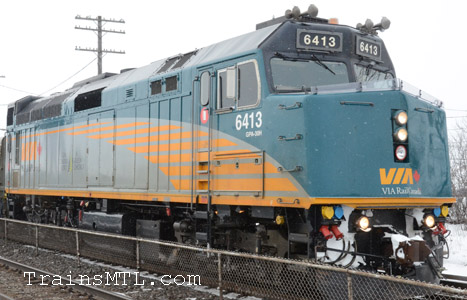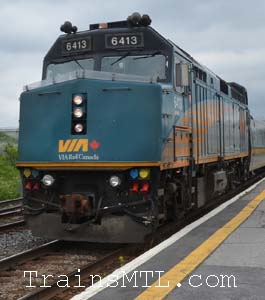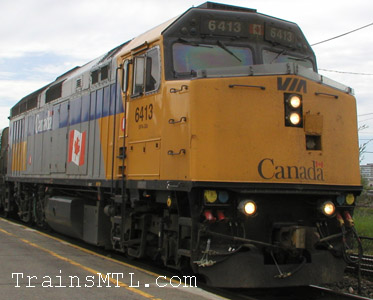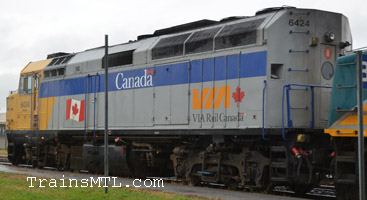
VIA6413 (right side / coté droit)

VIA6413 (left side / coté gauche)

(Locomotive VIA6413 with old colors / Locomotive VIA6413 avec les "vielles" couleurs)
Company / Compagnie............:VIA Rail
Model / Modèle.........................:F40PH-3h
Manufacturer / Constructeur...................: General Motor Electro Division.
Year build / Année de fabrication.............:1986
Power / Puissance.......................: 3000 H.P. (2400 HP, with HEP used / quand HEP utilisé),
for the rebuild one, power unknown / pour les locos rebatis, puissance inconnue.
Motor / Moteur:..............................: 645E3 (16 cylinders)
Traction type / Type de traction....: DC
Number of traction motors / Nombre de moteur de traction: 4
AAR wheels arrangement / AAR arrangement des roues: B-B (2 trucks of 2 traction axles / 2 trucks de 2 essieus de traction)
Speed / Vitesse.............................................:59 Mph (95km/h)
Wheel diameter / Diamètre des roues..........:40 po (101.6 cm)
Quantity of oil / Quantité d'huile ...................: 243 gallons (919.9 litres)
Quantity of water / Quantité d'eau.................:254 gallons (961.5 litres)
Fuel thank capacity / Cap. réservoir carburant: 1500 gallons (5678 litres)
Weight / Poids.................................: 260000 Lb (117934 Kg
Lengh / Longueur.............................:56 pi 2 po (17.1m)
Width / Largeur................................: 10 pi 3.5 po (3.14m)
Height / Hauteur...............................: 15 pi 7.5 po (4.76m)
The VIA F40PH series have a lot of history at VIA!
VIA bought the first 20 F40PH-2s class GPA-30a in 1986, 10 moreF40PH-2 but class GPA-30b were bought in 1987. Another batch of F40PH-2 class GPA-30c of 19 was the final order from EMD in 1989.
The description of the class goes as follow: G for General Motors Electro Division, P for Passenger, A for A unit, 30 for 3000 HP and the letter is for the generation (class) of the F40PH-2. The original were "a", "b" and "c" but between 2009 and 2012, the locomotives were rebuild, there class became d or h and the model became F40PH-3D. One of the most recognizable feature on the new rebuild F40PH-3D are the "bulge" at the rear of the locomotive that house the new HEP generator, where, before, there used to be a walkway before.
Les F40PH ont beaucoup d'histoire chez VIA.
VIA a fait l'acquisition de ses 20 premiers F40PH-2 class GPA-30a en 1986. En 1987, 10 F40PH-2s class GPA-30b ont été acheté. In dernier groupe de 19 unités F40PH-2 class GPA-30c sont arrivé en 1989 de chez EMD
Pour la description de la class; voici ce que ça donne : " G " pour General Motor Electro Division, " P " pour Passager, " A " pour unité de type " A ", " 30 " pour 3000 HP et la lettre décrit la génération (class0 du F40PH-2s. Les originaux étaient " a ", " b " et " c ", mais quand, entre 2009 et 2012, les locomotives ont été rebâti. Leurs class est devenues " d " ou " h " et le modèle est devenu F40PH-3d. Un des éléments facilement reconnaissable des nouveaux F40PH-3D est la " bosse " qui abrite le nouveau générateur HEP à l'arrière de la locomotive, ou, auparavant, il y avait une passerelle.

At the time of writing this article, 53 of the 59 F40PH-3D are still in use by VIA today.
In the original state, the F40PH-3d was able to deliver 3000 HP, but when the HEP generator was in use, the F40PH-2s delivered 2400HP. With the new HEP generator, with its own diesel motor, the power in HP of the new F40PH-3D is unknown.
The speed for the VIA 6400 series F40PH-3D are as follow:
- - For the 6400 to the 6436, the maximum speed is 95 km/h
- - For the 6437 to 6458, the maximum speed is 90km/h.
Sadly, after having been rebuild a few years ago, I expect the F40 to quietly disappear soon, being replace by newer equipment and more efficient equipment. I have good memory from working on them years ago.
Au moment de l'écriture de cet article; VIA utilise encore 53 de ces locomotives..
Dans son état original; le F40PH-3d donnait 3000 HP, mais quand le générateur HEP était utilisé; la puissance tombait à 2400 HP. Avec le nouveau générateur HEP qui possède maintenant son propre moteur diesel, la puissance du F40PH-3D est inconnue.
La vitesse maximum de la série VIA 6400 F40PH-3D va comme ceci :
- - Du numéro 6400 à 6436 inclusivement, la vitesse maximum est de 95 km/h.
- - Du numéro 6437 au numéro 6458, la vitesse maximum est de 90 km/h.
Tristement, après avoir été rebâties, il y a quelques années, je m'attends de voir les F40 silencieusement disparaître bientôt, remplacer par des équipements plus nouveaux et performants. J'ai des souvenirs plaisants d'avoir travaillé sur ces équipements il y a plusieurs années.
Reference / Référence: locomotive.wikia.com, thedieselshop.us et Canadian Trackside Guide